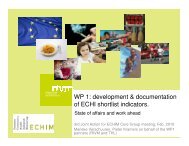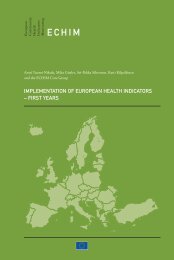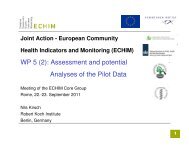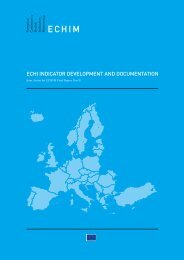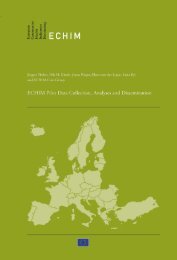INDICATORS
ECHIM Final Report
ECHIM Final Report
Create successful ePaper yourself
Turn your PDF publications into a flip-book with our unique Google optimized e-Paper software.
31. INJURIES: WORKPLACE<br />
Definition: Incidence of accidents at work. An accident at work is a discrete occurrence that<br />
occurs during working hours in connection with wage-earning employment or independent<br />
business which leads to physical or mental harm. Occurrences having only a medical origin,<br />
and occupational diseases are excluded. The indicator can be divided into a) serious and b)<br />
fatal accidents. A serious accident is one that causes more than three days absence from work.<br />
A fatal accident is defined as an accident which leads to the death of a victim.<br />
Calculation:<br />
1) Eurostat/ESAW: a) The incidence rate of serious accidents at work is the number<br />
of accidents at work resulting in more than 3 days’ absence per 100 000 persons in<br />
employment. b) The incidence rate of fatal accidents at work is the number of fatal accidents<br />
at work hat occurred during the year per 100 000 persons in employment.<br />
2) Number of respondents having had an accident at work during the past 12 months,<br />
derived from EHIS questions HS.7 and HS.8: HS.7 In the past 12 months, have you had<br />
any of the following type of accidents resulting in injury (external or internal)? 2. Accident<br />
at work (yes / no). If yes: HS.8 Did you visit a doctor, a nurse or an emergency department<br />
of a hospital as a result of this accident? (Yes, I visited a doctor or nurse / Yes, I went to an<br />
emergency department / No consultation or intervention was necessary).<br />
3) WHO: a) Number of persons injured/died/diseased due to work-related accidents per<br />
100000 (indicator 4060; 110502); b) Number of deaths due to work-related accidents per<br />
100000 (indicator 4070; 110503)<br />
Notes: Often the evolution of the incidence rate of serious accidents at work is expressed<br />
in comparison to a reference year (which has the value of 100) to minimize the influence of<br />
differences between national data collection systems.<br />
1) Eurostat/ESAW: Serious accidents. An accident at work includes accidents in the course<br />
of work outside the premises of his/her business, even if caused by a third party, and cases of<br />
acute poisoning. It excludes accidents on the way to or from work, occurrences having only a<br />
medical origin, and occupational diseases.<br />
2) Surveys: Only (serious) accidents, it not possible to estimate the number of fatal accidents.<br />
3) WHO: All accidents. Occupational injuries include deaths, personal injuries and diseases<br />
resulting from work accidents. Work accidents are accidents occurring at or in the course<br />
of work which may result in death, personal injury or disease. All industries are included.<br />
Commuting accidents on the way to or from work are excluded.<br />
32. SUICIDE ATTEMPT<br />
Definition: Proportion of persons having ever attempted suicide.<br />
Calculation:<br />
1) Percentage of those who gave a positive answer to the CIDI question: “Have you ever<br />
attempted suicide?” (variant 1a is preferred)<br />
a) question about suicide attempts asked from all respondents<br />
b) question about suicide attempts asked only if depression sieve is passed.<br />
2) Child Health Indicators of Life and Development (CHILD) project: Annual incidence of<br />
attempted suicide, defined by inpatient hospital stays with a discharge diagnosis of attempted<br />
suicide, per 100 000 population, in age-groups 10–14 and 15–17.<br />
102





